Research and Application of Business Law Information Management System Based on Big Data
Abstract
China’s manufacturing industry has set off a wave of digital transformation innovation, and the commercial law information management system, as one of the important tools to enhance the intelligent management ability of enterprises, will also face a new round of reform and upgrade. Building an “intelligent commercial law information management system platform” is the primary transformation path for traditional manufacturing enterprises to realize intelligent upgrading of commercial law information management system. The “intelligent commercial law information management system platform” is a management information sharing service platform that enables enterprises to achieve the goal of collaborative management by integrating their own business models and product technology needs with the help of emerging digital technologies, which can help enterprises realize the organic integration of business processes, risk management, value creation, and other management needs and change the original. The platform can help enterprises realize the organic integration of business processes, risk management, value creation, and other management needs and change the focus of the traditional financial shared service center, so that the enterprise business law information management system can be shifted to the enterprise strategy-oriented, focusing on risk control, decision support, and other high-level management. Therefore, it is particularly important to evaluate and optimize the “intelligent business law information management system platform” of manufacturing enterprises in the process of digital transformation. In this context, this paper conducts research and application of commercial law information management system based on big data, conducts an in-depth study on the current status of commercial law information management system in China, and provides an outlook on commercial law information management in China by establishing a relevant model system.
1. Introduction
In recent years, China’s manufacturing industry has embarked on a digital transformation innovation boom, and the commercial law information management system, as one of the important tools to enhance the intelligent management ability of enterprises, will also face a new round of reform and upgrade. Building an “intelligent commercial law information management system platform” is the primary transformation path for traditional manufacturing enterprises to realize intelligent upgrading of commercial law information management system [1]. The “intelligent commercial law information management system platform” is a management information sharing service platform that enables enterprises to achieve the goal of collaborative management by integrating their own business models and product technology needs with the help of emerging digital technologies, which can help enterprises realize the organic integration of business processes, risk management, value creation, and other management needs and change the original. This platform can help enterprises realize the organic integration of business processes, risk management, value creation, and other management needs and change the focus of the traditional financial shared service center, so that the enterprise business law information management system can be shifted to the enterprise strategy-oriented, focusing on risk control, decision support, and other high-level management work [2]. Therefore, it is particularly important to evaluate and optimize the “intelligent business law information management system platform” for manufacturing enterprises in digital transformation.
Currently, the digital economy is still the main driver of high-quality economic growth in China, so the digital transformation of traditional production industries is the trend, state-owned enterprises (SOEs) play a leading role in the wave of technological and industrial transformation, and their digital transformation can lead the rapid transformation of China’s enterprises and further strengthen their own strength, thus gradually becoming the focus of this wave of economic change [3]. In August 2020, the State-owned Assets Supervision and Administration Commission of the State Council issued a document on accelerating the digital transformation management of SOEs, in which it was clearly pointed out that SOEs should strengthen the infrastructure of pillar capabilities, form a digital transformation mechanism and be supervised by the enterprise management, and establish a systematic management assessment system from multiple perspectives, such as business and management, to evaluate the transformation effect in stages and achieve a continuous improvement with each iteration. The effect of continuous improvement is achieved iteration by iteration [4]. The “intelligent business law information management system” brings new changes in internal reporting, early warning and prediction, analysis, and decision making with the integration of “data + management.” In the process of redefining and improving the management model of enterprises through digital transformation, data resources need to be unlocked to their corresponding value, and it is not enough to rely on digital technology alone, which requires “intelligent commercial law information management system” to become a more powerful support base [5]. The current situation of the input of commercial law information management system in China is shown in Figure 1.
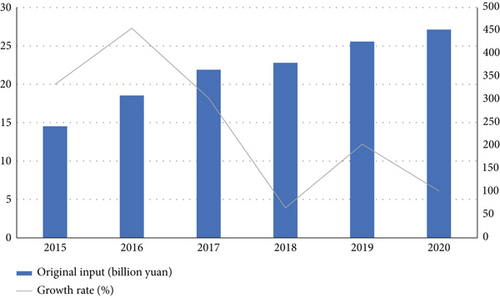
At the same time, China faced a major impact of the new pneumonia in 2020, and the relevant departments of the country indicated that they should make up for the problems and weaknesses of the relevant industries exposed during the prevention and control of the epidemic as soon as possible, vigorously develop the new industries and new models that emerged during the prevention and control of the epidemic, promote the development of the industrial Internet, promote the coordinated development of various industries, give birth to more new industrial models, give full play to the foundation and support of the new digital infrastructure, and improve the risk warning and information management system. Support role, improve risk warning and control ability, and then promote the digital transformation of manufacturing industry [6]. Based on this, a systematic all-round assessment of enterprises in the process of digital transformation of state-owned enterprises can clarify the digital stage and the internal and external challenges faced by the transforming enterprises, so as to subsequently develop a more reasonable digital transformation plan [7].
2. Research Background
With the increase of labor and production costs, manufacturing enterprises are facing problems related to the overall increase of operating costs, and some of them have difficulties in maintaining their competitiveness in the era of big data; therefore, it is a natural step for manufacturing enterprises to implement digital transformation and make digital transformation as a new strategic model for enterprises [8]. The digital transformation of a company is to innovate the business operation model with the purpose of shaping the digital enterprise integration management by integrating manufacturing and financial management with the help of digital technology. According to the business characteristics of manufacturing companies, the company should enhance its development capabilities, integrate digital technologies, reconfigure corporate strategies, and promote internal reforms in order to promote the digital transformation of the company [9].
The digital transformation of enterprises should improve the performance of enterprises through intelligent technology and through the use of digital technology, which in turn helps enterprises to eliminate data silos between various departments in their industries and upstream and downstream enterprises in the supply chain, improve the overall production and operational efficiency of enterprises, and, in this way, build a new technological enterprise ecological model for enterprises [10]. However, there are relevant theories that digital transformation is the direction of thinking for the whole enterprise, that is, the enterprise uses digital technology to transform the operation of each sector of the enterprise by reconstructing the value proposition of upstream and downstream customers and then urges the value creation of traditional manufacturing enterprises and the rearrangement of business models after transformation to ensure that the enterprise can sustain its core competitiveness in the industry in the digital economic system; in addition, there are scholars who believe that putting digital transformation is a strategic transformation of the company [11]. There are also theories that for a company to be successful in digital transformation, in addition to relying on advanced digital technologies, it is important to consider the adaptation of digital technologies in all sectors of the company: digital technologies are a means, not the ultimate goal of digital transformation. Some foreign scholars have analyzed the factors influencing corporate transformation from an empirical point of view, pointing out that web technologies and cloud computing have improved the business performance of companies to a certain extent, thus contributing to their transformation [12]. The key to successful corporate digital transformation lies in the integration of internal and external resources and the effective management of internal and external capabilities, while external capabilities are the key to achieving digital transformation [13].
In terms of the opportunity for digital transformation of enterprises, the study found that South African banks adopted digital transformation based on government regulation, i.e., South African banks were required to conduct regular reviews of customers in response to government demand, and thus, tedious and repetitive tasks prompted them to undergo digital transformation. Digital transformation by companies is driven by customer needs and digital technology [14]. Some scholars have described the opportunities for digital transformation of enterprises across systems based on the difference between digitalization and industrialization in two ways: first, the nature of enterprise resources and information architecture has changed essentially; second, enterprise management has undergone adaptive changes. Some theories, based on the development trend of the new generation of information technology, conclude that companies face social pressures based on high payroll labor costs, which promote the rapid development of artificial intelligence technologies, thus creating a domino effect and accelerating the digital transformation of companies [15]. It has been found that manufacturing companies undergoing digital transformation have a cohort effect and are highly influenced by companies in the same industry and prone to imitation learning. For the study of enterprise digital transformation paths, some scholars, from three aspects of capacity, path, and direction of China’s manufacturing enterprises, face the digital transformation dilemma, and according to the transformation dilemma faced by the manufacturing industry from improving dynamic capabilities, integration of traditional and emerging business, synergistic multisubject environment, and open sharing four aspects of the transformation path. Some foreign theories believe that digital transformation of enterprises is the transformation of business model from product to service, which affects the value acquisition and innovation mode of enterprises and makes them reap efficient operation efficiency and performance management under the new business model of “product + service.” A scholar in Beijing believes that in the new era of digitalization, enterprise management has transformed from enabling to enabling, so he tries to build a digital enterprise operation theory and improve the path of efficient operation of enterprises. Based on three central enterprises that have successfully achieved digital transformation, a scholar in Jiangsu attempts to build a digital transformation strategy targeting state-owned enterprises, so as to choose the path of digital transformation for enterprises. A scholar in Dalian believes that most of China’s military enterprises have not realized digitalization, and only a few are in networked management, so it is believed that their digital transformation mainly includes (1) implementing intelligent management, integrated management, and analysis of the enterprise’s operation data to help the implementation of business decisions; (2) applying intelligent manufacturing in the whole production process to achieve upstream and downstream collaboration; and (3) establishing refined digital design and simulation research system to improve product configuration, production management. The current status of the construction of intelligent commercial law information management system in China’s enterprises, measured by relevant indicators, is compared with foreign countries, as shown in Figure 2.
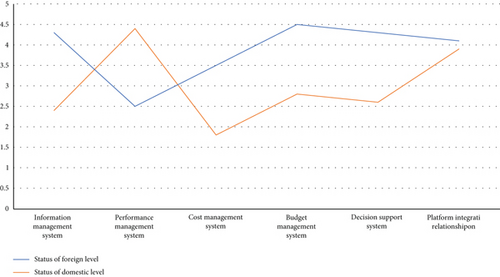
In addition, this paper also explores the demand for intelligent commercial law information management system platform for enterprises, which includes the following four indicators, as shown in Figure 3.
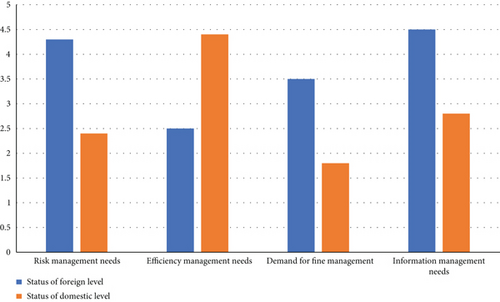
From the perspective of business law information management system, this paper considers the digital transformation mode of case enterprises from both business and financial aspects and takes the “intelligent business law information management system platform” applied in the digital transformation of manufacturing industry as the research object, combining business, digital technology, enterprise strategy, and other factors. First, this paper explores the current situation of “intelligent commercial law information management system platform” and analyzes the requirements from four aspects: efficiency management, risk management, information management, and fine management. In this paper, we evaluate and analyze the “intelligent commercial law information management system platform” with reference to the relevant natural environment carrying capacity assessment model and the comprehensive evaluation method of multiple indicators and then explore the optimization and development of the “intelligent commercial law information management system platform,” so as to provide a framework for the subsequent development of digital transformation of manufacturing enterprises. The framework for the subsequent development of digital transformation of manufacturing enterprises is then explored.
3. Materials and Methods
3.1. Basic Theory
3.1.1. Big Data Collection and Management
The research content of this paper is about the discussion of the network literacy education system of college students under the big data media management mode. Therefore, the collection and management system of big data is to be utilized. The big data management system utilized today can not only store a large amount of data and form a large amount of data storage network system but also analyze and process the data extremely fast. Big data management system is to analyze and process all kinds of data by using the medium of computer and network reasonably. It is being used in various aspects of life in an increasingly fast and convenient way of digital information transmission and processing, which brings a great degree of information convenience to people’s future learning life, updates the traditional view of data management, provides a more innovative and convenient way to store and process a variety of data, and greatly improves people’s work efficiency [16]. The big data management system has four main features such as large storage volume, rapid information processing, real and effective data results, and a wide variety of data types, as shown in Figure 4.

3.1.2. Commercial Law
Commercial law belongs to a type of civil law and is added to the relevant legal sector as a supplementary law [16]. Commercial law is a law that regulates the equal commercial relations between different individuals, enterprises, and other subjects. Commercial law includes a wide range of laws, such as corporate law, credit law and related bankruptcy insurance, and other laws related to the economy. Of course, from the point of view of definition, commercial law is mainly to adjust different subjects of transactions, such as individuals, enterprises, government, and other subjects in their commercial behavior formed by some relations, this relationship is mainly commercial relations, so as the name suggests, the People’s Republic of China commercial relations law, it is the name of commercial law. There is a rich variety of commercial law [17].
From the perspective of new institutional economics, the main purpose of commercial law in China is to reduce the related transaction costs in the future. The second is to ensure fairness for both easy parties. Ensuring the safety of the transaction process is carried out smoothly, and second, the process of the transaction is also regulated quite strictly; he can ensure that the transaction does take place. The last point in its function is that it ensures the improvement of the efficiency of the economy, which can increase the total social gain and reduce the total social cost, and in the process of business transactions can also increase the total gain and reduce the total cost of the enterprise [18].
The principle of honesty and trustworthiness is a relatively common civil and commercial law imperial clause under the modern industrial system, which plays a universal role of restraint and control in all types of market economies. The principle of honesty and trustworthiness will always be the primary principle of civil and commercial law as long as the market economy is in place. Of course, the principle of honesty and trustworthiness also imposes relevant requirements on the enforcement of law by law enforcement officers, which requires them to be able to enforce the law flexibly and with certain discretionary power [19].
Typical commercial laws are mainly corporate laws and related bonds, financial industry management laws related to note management, and related laws extended from here. The types of commercial law in China have been gradually enriched with the further development of reform and opening up, and the following ten main types of commercial law have been formed in Fujian, which have been used until now, as shown in Figure 5.
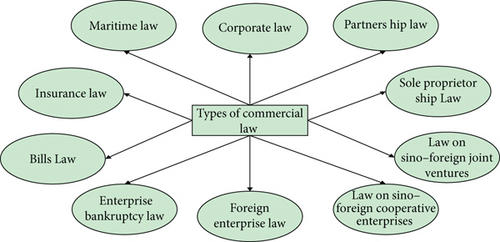
3.1.3. Information Management System
Enterprises improve the system data processing capability by introducing big data technology, so its information management system can provide multiangle data analysis for system users and enable enterprise managers to manage and supervise the enterprise from multiple perspectives. At the same time, the information management system should provide timely feedback of relevant information and facilitate the transfer of relevant data of the enterprise among various systems. The “intelligent business law information management system platform” includes cost management system, budget management system, performance management system, and decision management system; and each subsystem can realize its functional requirements with the help of the “intelligent business law information management system platform.” In order to strengthen information management, enterprises should make use of advanced technology to optimize their information management and accounting platform to meet the changing needs of production management. In the general environment of information technology, the control of enterprise financial information system includes cost control and risk warning control. There are specific economic activities in the production process of enterprises, such as personalization of cars, which should be integrated into the management of business processes when analyzing their functional requirements. At the same time, with the help of big data and artificial intelligence technologies, it is possible to play a predictive role in process management in the business process. For example, process automation management in enterprises is being rapidly applied in the field of finance, while for repetitive and well-organized processes, an intelligent platform can help improve the efficiency of financial process management.
3.2. Research Methodology
3.2.1. Information Management System Evaluation Method
Set (Ω, ζ, P) up is a conceptual space, and x is the set of all wandering variables on the space involved. A risk measure ρ is a mapping x from a xρ subset of R to the real numbers, denoted as ρ : X ∈ xρ↔ρ(X) ∈ R.
Here is g the distortion function, which SX(x) = P(X≻x) is X the tail distribution.
3.2.2. SQL Server Big Data Management System
On the basis of the mainstream Windows and other operating system platforms, SQL Server database as a new generation of database and analysis processing platform software is rapidly being widely used and widely accepted by enterprise customers. Different from other current database platforms such as FoxPro and smaller databases such as CCESS database, SQL Server has a complete powerful and easy to use database management and service processing functions, an engine that supports development, standard database languages such as SQL, and extended feature functions such as replication, OLP, and analysis. It is also clearly ahead of the rest of the market in other key features such as stored procedures and triggers that only large database software can provide [20].
Microsoft SQL Server 2010 is based on Microsoft SQL Server 7.0. It greatly expands database performance, reliability, quality management, and ease of use. Microsoft SQL Server 2010 Database edition is a high-performance enterprise relational database management system with high reliability and ease of use. SQL Server 2010 features are comprehensive and specific, as shown in Figure 6.
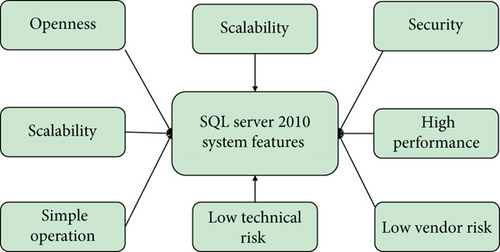
Therefore, this paper selects SQL Server 2010 for big data analysis, the first is SQL Server 2010 version has been relatively mature; second, SQL Server is used to manage large databases, that is, to analyze the use of big data, the use of this software is more appropriate. Finally, SQL Server is a more commonly used software for analyzing big data, which makes it easier for other researchers to understand this paper.
3.2.3. Oracle Big Data Analysis and Research
Oracle Database Management System, a database management system developed by the German company Oracle Software. It is probably another database product that Microsoft will design with distributed database as its core feature. It will also be one of Microsoft’s most popular distributed C/S server architecture or distributed B/S database architecture in the world. State “questioning” is one of the most attractive performance advantages of Oracle’s parallel Server model compared to SQL Server databases. It allows you to split any subquery into any number of subqueries and then execute the subroutines on two different server CPUs. Greatly improve the performance of multiprocessing systems, which should be a potential competitive advantage in the next few years of rapid growth of the data trend. The Oracle database has a number of other significant advantages over the Oracle database: complete data storage management storage capability. The data storage capacity is large, the persistence time is long, and the data can be shared, ensuring reliability. It has the features of perfect management function and simple operation, as shown in Figure 7.
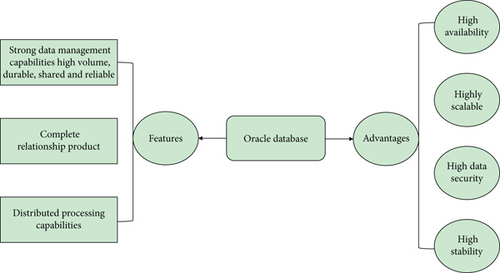
4. Results and Discussion
4.1. Demand Analysis of Enterprise Intelligent Commercial Law Information Management System Platform
The research on “intelligent commercial law information management system information platform” is still in its infancy, and the corresponding theoretical system is lacking. It is difficult to provide reference suggestions for the company in the realistic transformation process. Therefore, since the enterprise started the digital transformation strategy, the information system function of the commercial law information management system is relatively single, which needs to be further improved. At the same time, most of the “intelligent commercial law information management system information platform” used by Chinese traditional enterprises is divided into outsourcing software and independent research and development. The enterprise independently develops “intelligent Commercial law information management system information platform” by combining its own operation situation, to meet the daily operation and development of the enterprise. Therefore, this big data information platform, under the guidance of the enterprise's own development strategy, can ensure the transformation and upgrading of enterprise management, improve the management system, optimize business processes, and build a scientific organizational structure. Therefore, based on the analysis of enterprise industrial characteristics and platform function modules, this paper expounds the requirements of “enterprise intelligent commercial law information management system platform” from four aspects, namely, risk management, efficiency management, fine management, and information management, considering demand acquisition and demand transformation. Under the background of digital transformation, the intelligent commercial law information management system takes the integration of industry and finance as the transformation goal. The functional demand of “enterprise intelligent commercial law information management system platform” first faces the production demand of enterprises. The way of obtaining the production demand of enterprises is the new mode of modern manufacturing industry transformation and production. It is a demand acquisition mode based on the comprehensive comparison between customers’ personal preferences and suppliers’ needs to provide relevant services and improve the production value of enterprises. According to the industry characteristics of traditional vehicle manufacturing enterprises under digital transformation, the whole production demand acquisition process mainly consists of two aspects: demand service from customers: product demand analysis, production decision optimization, etc., and then give customers the overall planning solution to solve the corresponding demand; productive demand from suppliers: according to matching production demand, respond to the production workshop facing quality assessment, production rework, product design, and production resource problems when production capacity is insufficient. According to the above production demands, enterprises map to the “Enterprise Intelligent Business Law Information Management System Platform,” and managers can take relevant measures immediately through the platform.
The digital unified management of the “intelligent business law information management system platform” supports the whole process, and the “intelligent business law information management system platform” obtains the enterprise production demand decision, and according to the customer demand and the service provided by the upstream production suppliers, the “Enterprise Intelligent Business Law Information Management System Platform” obtains the enterprise production demand decision, and according to the customer demand and the service provided by the upstream production supplier to make intelligent matching, generate the corresponding production and manufacturing plan. After that, the “Enterprise Intelligent Business Law Information Management System Platform” screens out matching production suppliers based on the service demands of upstream suppliers, reshapes the production process according to the demand production plan, and is supervised by the enterprise production department to provide enterprise products and services to customers and suppliers. Production demand coordination and demand matching are the two processes of the first stage of demand acquisition and then realize the second stage of intelligent production and after-sales tracking. Production demand acquisition is an important part of the “intelligent business law information management system platform” to complete the decision-making service, which also provides the relevant basis for the demand analysis of each sub-system of the “intelligent business law information management system platform.”
4.1.1. Demand Transformation Classification
Based on the understanding of the production demand acquisition mechanism of the “intelligent business law information management system platform,” it can be found that the enterprise’s customer and service demands need to be classified and summarized before being processed by the “intelligent business law information management system platform,” and the enterprise by drawing on the transformation of various types of demand, the company reconstructed a more suitable demand strategy and planning. According to the characteristics of the manufacturing industry, the requirements can be divided into the acquisition of functional requirements knowledge, integration, and sharing. Therefore, this paper briefly describes the dissemination form and transformation mode of demand resources in each stage of “intelligent business law information management system platform” with the help of relevant functional demand acquisition model. As a kind of digitally available resource, the platform requirements can be divided into internal and external requirements acquisition channels by analogy with the idea of knowledge acquisition, and then, the two channels can be integrated. By integrating and summarizing the acquired demand resources from different knowledge sources such as external information system or customer’s mind and converting them with the help of relevant digital technology such as computer language, enterprises can be recognized by the “intelligent business law information management system platform” and carry out digital process management and intelligent decision support.
4.1.2. Risk Management Requirements
The risks faced by the “intelligent business law information management system platform” cover the following points: first, the security of information obtained through the platform, such as the existence of financial differentiated information between systems and the risk of false transactions in the sales system; while the platform obtains the management information of the enterprise with its own information database, it needs to ensure the security of confidential information. Security issues, with the development of business, enterprise transaction data can be a reference basis for the production of risk management. Second, through the business on the cloud operation instead of manual management, although digital technology can be used to avoid operational risks brought about by manual errors, but also need to ensure that the quality of data audit, in order to avoid irreparable major risks arising. In addition, the platform also faces the unknown objective environmental risk crisis and needs to strengthen the continuous maintenance and data backup of the platform. Therefore, the “intelligent business law information management system platform” needs to help enterprises grasp the future strategic direction with the help of more predictable and refined enterprise core business data and then provide support for decision makers and effective management control of enterprises. For production planning and sales business, it is necessary to make prediction on project expectation, control the completion of any project task, make centralized planning and solution with the help of relevant functional modules of the platform, and then assist “intelligent business law information management system platform” to make effective judgment on the rationality of production planning and actual implementation of each process. Therefore, the current “intelligent business law information management system platform” cannot fully meet the needs of enterprise risk management.
4.1.3. Efficiency Management Requirements
The efficiency management of “intelligent business law information management system platform” includes business processes, financial management, and other types of delivery time differences, platform data processing efficiency, etc. Since the efficiency management of financial projects includes project payment management, payment confirmation time, and platform processing time, the combination of business optimization and digital technology can change the efficiency management of enterprises. It can be seen that, in addition to strengthening the “enterprise intelligent business law information management system platform,” it is also necessary to link the sales management system to take the lead in screening good credit customer feedback to the financial system for priority payment, and thus shorten the payment time; based on this, the enterprise can improve efficiency and strengthen the control of capital flow and sales process at the same time. Second, in the reimbursement business, efficiency management is the focus of the “Enterprise Intelligent Business Law Information Management System Platform.” In the validity management of financial statements, a credit evaluation model is built using the user’s past data, exempting bills within a certain amount and giving priority to customers with good credit, and combining performance management and information management systems. Performance management and information management system are combined to achieve the purpose of collaborative management. The application of big data technology can replace part of the manual audit and improve the efficiency of the reimbursement business, but for the “enterprise intelligent business law information management system platform,” there is a need for continuous planning efficiency management needs.
4.1.4. Demand for Fine Management
The refined management of “intelligent business law information management system platform” can realize the control of the whole process of production and operation activities of enterprises before, during, and after the event. At present, the “intelligent business law information management system platform” is mainly responsible for the midevent record and postevent accounting, and the pre-event planning is relatively little reflected in the platform, which is difficult to meet the needs of the enterprise’s intelligent business law information management system. Therefore, “intelligent commercial law information management system platform” needs to refine and reshape the business process of the enterprise, which helps the enterprise to grasp the whole business process comprehensively, not only limited to the core business process but also improves the refinement management to help the enterprise managers pay attention to the connection between each process. Overlapping, it can further promote the integration of enterprise business and finance and inject the management concept of business law information management system into business activities to achieve effective management control, thus eliminating the silo of information. Therefore, the current “intelligent business law information management system platform” is not well adapted to the enterprise’s refined management requirements.
4.1.5. Information Management Requirements
It is easy to see from the iterative update of the digital transformation path that at this stage, the basic information such as production plan and financial statement required by the operation management of the enterprise are all counted by the production management system and ERP system and filled in by mail and office tools in aggregate. Therefore, the platform information silo has become one of the problems found in the digital transformation of enterprises, and how to realize data automation and establish an efficient internal management information transfer system has become one of the transformation guidelines of “Enterprise Intelligent Commercial Law Information Management System Platform.” Although the “intelligent business law information management system platform” helps to collect a large amount of data and information from enterprises, without the establishment of an effective information integration platform, many information resources are only limited to use in a single department of the enterprise, which cannot give full play to the role of information resources and cannot bring positive significance to the operation and development of enterprises. Therefore, the “intelligent business law information management system platform” needs to reconstruct a suitable information interaction platform, accelerate information sharing, improve the speed of information circulation, and perfect information management needs.
4.2. Evaluation Analysis of Intelligent Business Law Information Management System Platform
4.2.1. Platform Selection and Applicability
The objective of the evaluation of the “intelligent business law information management system platform” in this paper is to explore the current situation of the digital transformation of enterprises and to formulate an optimization plan that can promote the digital transformation. Taking into account the digital transformation characteristics and strategic objectives of enterprises, the evaluation and analysis of the implementation status of the “intelligent commercial law information management system platform” will help enterprises determine the optimization path of the “intelligent commercial law information management system platform” and digital transformation. We will help enterprises to determine the optimization path of “intelligent commercial law information management system platform” and digital transformation. According to the previous demand analysis, the management goal of “intelligent commercial law information management system platform” needs to rely on the demand of each functional module to achieve; therefore, the platform evaluation should also take the improvement of each functional module demand as the subsequent optimization goal, and through the evaluation and analysis of the gradual optimization of relevant indicators in the platform, so as to finally achieve optimization and enhancement of “intelligent business law information management system platform.”
In the digital transformation of enterprises, the evaluation indexes of “intelligent commercial law information management system platform” have a certain complexity and wide scope, and enterprises can only develop evaluation and optimization paths according to the mutual influence relationship between the demand management and evaluation indexes of the enterprise platform. Therefore, in view of the actual situation of “intelligent business law information management system platform” and the scarcity of relevant reference assessment literature, this paper borrows the natural environment assessment method—resource and environmental carrying capacity assessment, and its assessment concept is closest to the assessment plan of this paper. The concept of the assessment is closest to the assessment plan of this paper, that is, under the constraint of the environmental carrying capacity, to understand the enterprise’s resource and environmental carrying status and development trend and use it as a basis for decision-making. We are looking for ways to further optimize the digital transformation and the “intelligent business law information management system platform” of the enterprise. Two models, PSR and DPSIR, are often used in regional resource and environment carrying capacity simulation studies. The PSR model can evaluate the coupling relationship between the influencing factors in the platform system and study the overall decision utility of the system through the interaction relationship between the systems, so it has certain applicability to the research problem of this paper. The model only focuses on the “growth limit” problem and lacks an early warning-oriented evaluation process for the current intelligent system platform. Wang Liang and Liu Hui combined the advantages and shortcomings of these two models, proposed a positive hexagonal interaction force model of resource and environment bearing based on the theory of “structural stability” and “growth limit,” decomposed the environmental bearing capacity into the sum of multiple forces, and used the filling degree of the positive hexagonal model to determine the environmental bearing capacity. The filling degree of the hexagonal model is used to simulate the dynamic changes of the information carrying capacity and risk tolerance of the “intelligent business law information management system platform,” so as to form an evaluation system applicable to the “intelligent business law information management system platform of enterprises.”
4.2.2. Comprehensive Analysis of Evaluation System Indicators
In recent years, the transformation from a traditional automobile manufacturer to an intelligent travel technology company is the main strategic goal of major automobile industries. Based on the demand of customer experience, traditional vehicle manufacturers build an automotive platform externally and an “intelligent business law information management system platform” internally to refine the management of each step of automobile manufacturing, sales, management, research, and development in fine detail and establish connections with close industries. In order to realize the digital reform of the whole enterprise, we have selected the enterprise as the research object. In this paper, the company is selected as the research object. Since the official announcement of the intelligent strategy in 2018, its internal “intelligent business law information management system platform” has been improved and adjusted on the basis of the previous ERP management platform. At the same time, after the establishment of the company’s intelligent strategy, relying on social resources, the company has injected a large number of intelligent professionals to accelerate the digitalization process of the enterprise. With the advent of the era of the Great Intelligence, researchers from all walks of life and all disciplines are extremely concerned about the future of each intelligent “replaceable” profession. For the digital transformation of enterprises and other related manufacturing enterprises, most researchers believe that it is indisputable, therefore, through the relevant assessment of the “intelligent commercial law information management system platform” within the enterprise, to determine the environment in which the platform carries the state so as to determine the “intelligent commercial law information management system platform.” Therefore, through the relevant assessment of the “intelligent commercial law information management system platform” within the enterprise, we determine the environmental bearing state of the platform and judge the mutual influence of the “intelligent commercial law information management system platform” and the digital reform of the enterprise. Further exploration is shown in Figure 8.
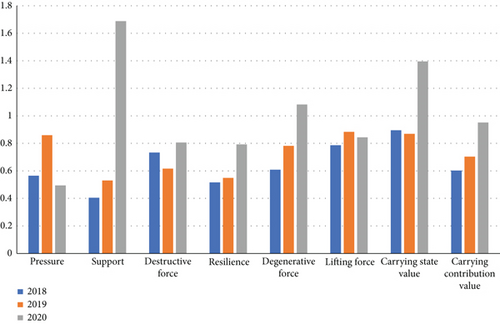
However, there are slight changes in the overall comparison, and the contribution value in 2019 represents the degradation and enhancement of the objective environment of the intelligent business law information management system. What is more, with the same concept that intelligent manufacturing industry is under increasing pressure, in 2019, China’s auto industry production and sales volume is the first in the world, the revenue scale is 808.47 billion yuan, and the overall profit of the industry is declining, “intelligent business law information management system platform for enterprises” compared to 2018. In 2019, the information pressure has increased significantly, while the platform’s destructive power has seen negative growth, as well as the platform’s supporting power has maintained a faster growth rate, which together makes the overall development of the enterprise more stable, and at the same time, we will also consider the objective fact that the enterprise has a smaller volume of its own resources compared with the industry and is subject to lower external influence. Based only on the environment in which the enterprise is located and its own resources as the basis of analysis, the “intelligent business law information management system platform” should be able to carry slightly more information than the current volume, while the “intelligent business law information management system platform” among manufacturing enterprises has a carrying capacity of is based on the existing information or resources of the enterprise, and the amount of information that can be carried within its capacity. The enterprise is closely coupled with upstream and downstream enterprises and loosely coupled with the platform system of other related enterprises, and the improvement of the platform’s ability to obtain information can indicate the expansion of the carrying capacity of the “intelligent commercial law information management system platform.”
5. Conclusion
China’s manufacturing industry has set off a boom of digital transformation, and the commercial law information management system, as one of the important tools to enhance the intelligent management ability of enterprises, will also face a new round of reform and upgrade. Building an “intelligent commercial law information management system platform” is the primary transformation path for traditional manufacturing enterprises to realize intelligent upgrading of commercial law information management system. The “intelligent commercial law information management system platform” is a management information sharing service platform that enables enterprises to achieve the goal of collaborative management by integrating their own business models and product technology needs with the help of emerging digital technologies, which can help enterprises realize the organic integration of business processes, risk management, value creation, and other management needs and change the original. The platform can help enterprises realize the organic integration of business processes, risk management, value creation, and other management needs and change the focus of the traditional financial shared service center, so that the enterprise business law information management system can be shifted to the enterprise strategy-oriented, focusing on risk control, decision support, and other high-level management. Therefore, it is particularly important to evaluate and optimize the “intelligent business law information management system platform” of manufacturing enterprises in the process of digital transformation. In this context, this paper conducts a research and application of commercial law information management system based on big data, conducts an in-depth study on the current status of commercial law information management system in China, and provides an outlook on commercial law information management in China by establishing a relevant model system.
Conflicts of Interest
The author declares no conflicts of interest.
Open Research
Data Availability
The dataset is available upon request.




